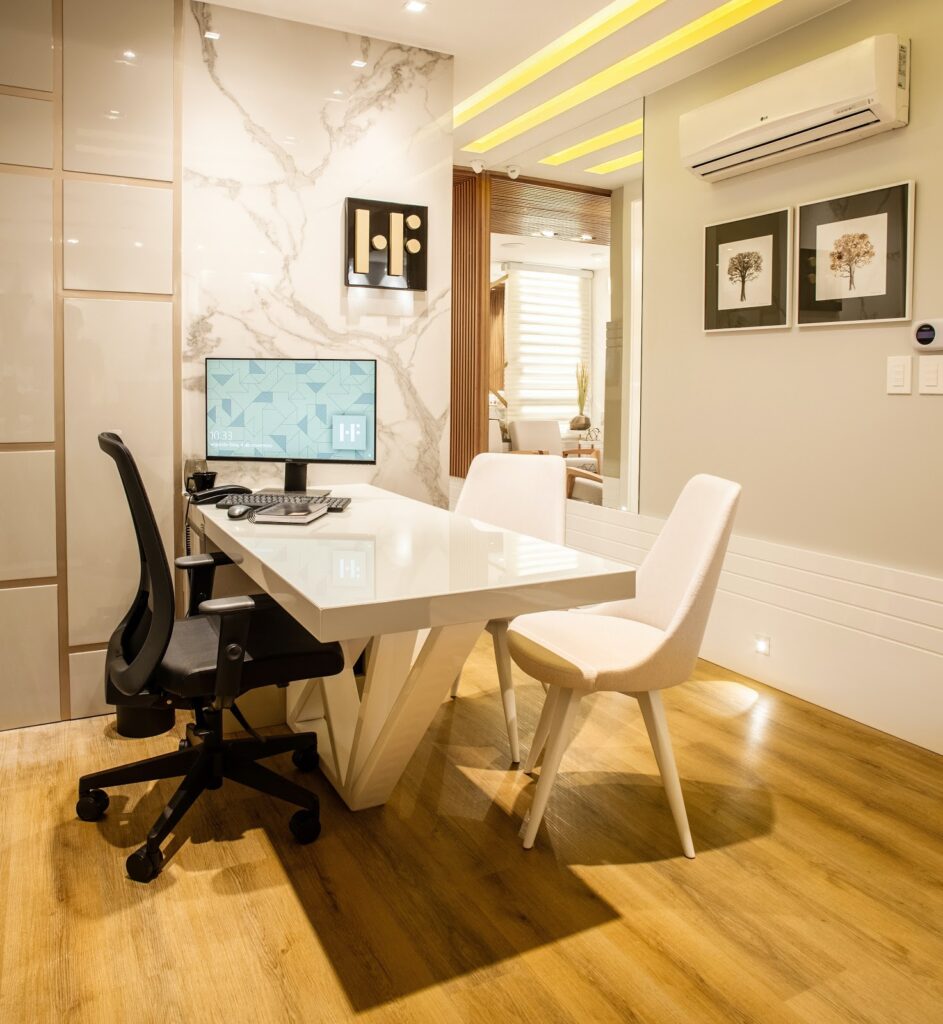This pandemic and its aftermath have changed how we work in significant ways – not just where we work but how we feel about our workplace. While many are still working from home, we are returning to the office, and we need to feel safe in the environment.
But what kinds of changes should we be making to our spaces? Here we have six design trends that are sure to make your business a safe and pleasant place for your employees.
1 Open floor plans
Open floor plan offices are back in style, and they’re better than ever. For the times we’re facing, open floor plans are functional, versatile, and have loads of potential. We’re able to reduce density and create clearly defined spaces for individuals without isolating them.
We can use loose furniture to create sub-sections of workstations, visitor areas, meeting spaces, and break zones. People can feel safe working in their own spaces. Open floor plan offices are easier to clean and limit the amount of surface area people need to touch.
Unfortunately, there are surfaces in the office that are most often touched – door handles, arms of chairs, and cubical openings, making it easy for bacteria to spread. HVAC systems are also an aid for spreading COVID-19. So, in addition to distancing in the office, ventilation is a must. If windows can’t be opened or are insufficient for ventilating the entire space, an office climate control system’s purchase may be in order.
Related: Re-Imagining Office Space and Work-Life After COVID-19
2 Workstations
Trying to create floor plans that give each person six feet of distancing between workstations will be challenging. Whether or not the government continues to mandate this may not be the issue, as many offices will feel the need for distancing regardless.
Our desks have become smaller over time – due to the obsoleting or reduced size of our work-related technology. But this isn’t advantageous for distancing purposes, so perhaps our desks will increase in size again.
Large tables may continue to be useful in open-plan layouts, but with fewer people sat around them. Flexible work schedules and remote working may be the solution to density issues in the office on any given day. Instead of eight people around a table, the new mandate would be for only 3, with the others not coming in on the same days. Alternatively, desks and tables may be modified to create enclosures for employees. Made of plastic or glass screening panels, people may work behind them feeling safe, but still able to see and interact with work colleagues or customers.
Where there isn’t enough room to create the kind of space necessary for safety and remote or flexible work schedules may be challenging, some businesses will have to move to larger spaces.
Another issue with workstations is the equipment most frequently used. It’s a good idea if employers can furnish their employees with laptops, tablets, or phones to work with at the office or at home, reducing the need for sharing. This will also keep the surface of the desks minimal and easy to keep clean.
Disposable, recyclable placemats may also be purchased as a means of protecting the work surfaces while they’re in use during the day. They can be recycled at the end of the day, leaving the cleaning crew a far easier job of sanitizing the workstation.
3 Smaller conference rooms – and more of them

As collaboration is still essential to many businesses, employees need to have spaces where they may work together – even if one is working from home. Smaller conference rooms will provide the space and tech for employees to connect frequently and with greater ease.
Some offices may have to invest in AV that is reliable and meets the company’s growing needs. The conference rooms should be refitted with doors that are motion-sensitive, swinging, or have no doors at all.
Related: Suburban Office Spaces: The #1 Choice After COVID-19
4 Furniture, appliances, and finishes
Not only must we re-think our office furniture, but we must re-consider their finishes. We need finishes that can easily be cleaned and sanitized.
For furniture, we’re looking for it to be kinetic, lightweight, and flexible. It must be easy to move and reconfigure, as well as easy to sanitize. Couches and chairs made of microfibre are good for cleaning spills and stains. Microfibre is designed for heavy use and stain resistance and is easy to maintain. A damp cloth with some alcohol is all it takes to clean furniture covered in microfibre fabrics.
For appliances in kitchens, pantries, and bathrooms, we have to become creative. Instead of one office refrigerator or dishwasher, which could become a depository for all manner of germs, businesses can have a few. This way, they can designate drawers or whole appliances to different departments.
Offices must think in terms of what finishes are easier to clean and what surfaces may clean themselves. NanoSeptic, have created skins and mats that self-clean continuously throughout the day. They turn germ-prone, high-traffic touchpoints into clean, safe places.
New and existing technology will make the workplace safer for everyone. Touch-less tech, like motion lights, motion sensors, and facial recognition software for entry into rooms, using bathroom and kitchen facilities and operating external doors and elevators.
5 Educating employees

We have become accustomed to floor stickers and decals in retail spaces that remind us to social distance. We need more of these in the office. At elevators, floor stickers can remind employees where to stand to wait while keeping distant from colleagues. Narrow hallways may be turned into one-way passageways, where possible.
And businesses need to be transparent with employees in matters of their health and well-being. Companies need to establish firm procedures and regulations around how work and people will flow through the offices for peace of mind and clarity. Assigned seating, clear directions, and regular updates might feel unnatural at first, but they are best practices for productive offices during this time.
Related: The Future of Office Leasing Post-COVID-19
6) Modular Walls
The significant part about Tailored Space is that they provide flexibility in the office environments where headcount, density, and government mandates can change instantly. Modular walls allow companies to convert space from small offices to large offices or even to an open area. The opportunity is endless when it comes to creating a modular all with Tailored Space.
7) Embrace our new norm
Never have we needed out of the box, innovative thinking in such urgency as we do today. Everything suddenly changed and has left us fighting for the survival of our companies and bottom lines. Some changes are frustrating to deal with, and many are impossible; however, there is an opportunity for massive improvement.
Companies should encourage employees to come up with solutions to issues in their offices and industries. Employees shouldn’t be held accountable for solutions, but rather, allowed to contribute. You may be surprised at their creativity.
Eventually, our new norm and the changes you make to your company could make you stand out among competitors and establish loyalty with your employees. People want to work where they feel safe, valued, and heard.